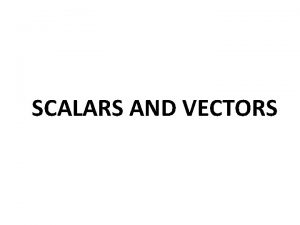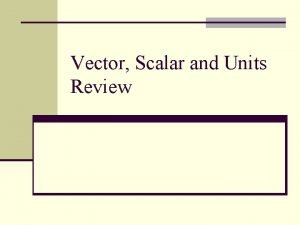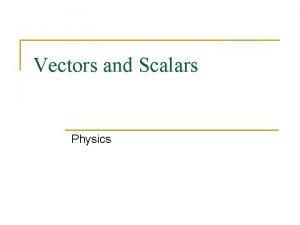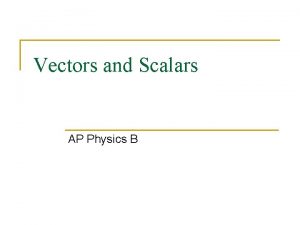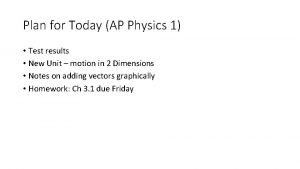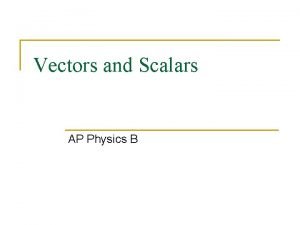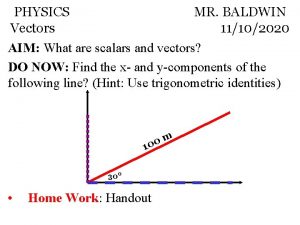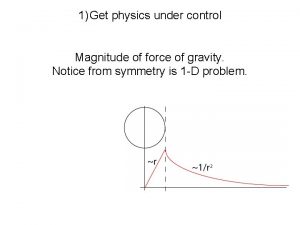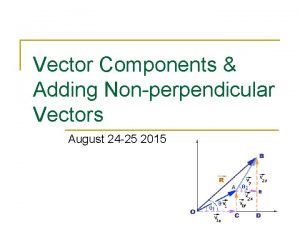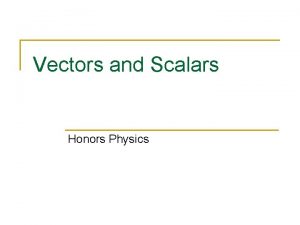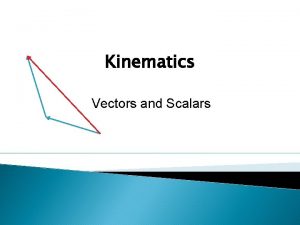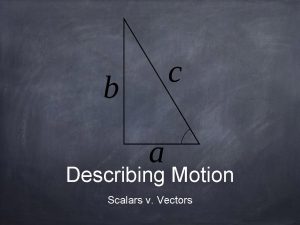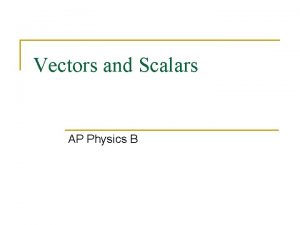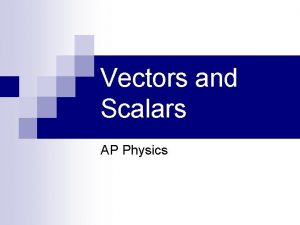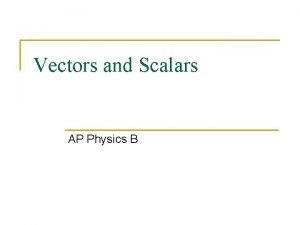Vectors and Scalars AP Physics C Scalar A






















- Slides: 22

Vectors and Scalars AP Physics C

Scalar A SCALAR is ANY quantity in physics that has MAGNITUDE, but NOT a direction associated with it. Magnitude – A numerical value with units. Scalar Example Magnitude Speed 20 m/s Distance 10 m Age 15 years Heat 1000 calories

Vector A VECTOR is ANY quantity in physics that has BOTH MAGNITUDE and DIRECTION. . Vector Velocity Magnitude & Direction 20 m/s, N Acceleration 10 m/s/s, E Force 5 N, West

Polar Notation Polar notation defines a vector by designating the vector’s magnitude |A| and angle θ relative to the +x axis. Using that notation the vector is written: How do we write this vector?

Polar Notation In this picture we have a force vector of 12 Newtons oriented along the -x axis. However, polar notation is relative to the + x axis. Therefore, it would be characterized by Answer: F= 12<180 In this last picture we have 2 vectors. They are characterized by: Answer: C=2<30 D=4<-50 or 4<310

Scalar Multiplication Multiplying a vector by a scalar will ONLY CHANGE its magnitude. Thus if A = 12 < 105, then what does 2 A equal ? How can we change the direction of a scalar? Answer: 2 A=24<105 -1/2 A Thus if A = 12 < 105, then what does – A equal? Answer: -A= 12<285 OR -A = 12<-75

Unit Vector Notation An effective and popular system used in engineering is called unit vector notation. It is used to denote vectors with an x-y Cartesian coordinate system.

Unit Vector Notation =3 j J = vector of magnitude “ 1” in the “y” direction i = vector of magnitude “ 1” in the “x” direction = 4 i The hypotenuse in Physics is called the RESULTANT or VECTOR SUM. The LEGS of the triangle are called the COMPONENTS 3 j 4 i Horizontal Component Vertical Component NOTE: When drawing a right triangle that conveys some type of motion, you MUST draw your components HEAD TO TOE.

Unit Vector Notation How would you write vectors J and K in unit vector notation? n n J= 2 i + 4 j K=2 i -5 j

Applications of Vectors VECTOR ADDITION – If 2 similar vectors point in the SAME direction, add them. n n Example: A man walks 54. 5 meters east, then another 30 meters east. Calculate his displacement relative to where he started? ANSWER: 84. 5 m + Notice that the SIZE of the arrow conveys MAGNITUDE and the way it was drawn conveys DIRECTION.

Applications of Vectors VECTOR SUBTRACTION - If 2 vectors are going in opposite directions, you SUBTRACT. n Example: A man walks 54. 5 meters east, then 30 meters west. Calculate his displacement relative to where he started? - ANSWER: 24. 5 m EAST

Magnitude of a vector The symbol |A| means the magnitude of vector A. The magnitude of a vector is equal to the square root of the sum of the squares of the components of the vector. |A|= √(Ax 2 + Ay 2 )

Non-Collinear Vectors When 2 vectors are perpendicular, you must use the Pythagorean theorem. A man walks 95 km, East then 55 km, north. Calculate his RESULTANT DISPLACEMENT. n 55 km, N 95 km, E n |R|=√((95 km)2 + (55 km)2 R= 109. 8 km

BUT…. . what about the VALUE of the angle? ? ? Just putting North of East on the answer is NOT specific enough for the direction. We MUST find the VALUE of the angle. 109. 8 km q N of E 95 km, E R = 109. 8 km<30 or 109. 8 km, 30 degrees North of East Or 95 i + 55 j 55 km, N Find the value of the angle. Write the resultant vector in the following: 1. Polar Notation 2. Cartesian unit vector form

What if you are missing a Suppose a person walked 65 m, 25 degrees East of North. What component? were his horizontal and vertical components? H. C. = ? V. C = ? 25 65 m VC = 65 cos 25 VC= 58. 91 j HC=65 sin 25 HC 27. 47 i

Adding Vectors Algebraically In order to add vectors algebraically, you must do the following: 1. Resolve each vector into components (For vector A, find Ax and Ay. For vector B, find Bx and By. And so on) 2. Add like components to find components of the resultant. (Rx=Ax +Bx +…, Ry=Ay+By+…) 3. Find magnitude of resultant and direction of resultant (|R|= √(Rx 2 + Ry 2 )

Example 1 A bear, searching for food wanders 35 meters east then 20 meters north. Frustrated, he wanders another 12 meters west then 6 meters south. Calculate the bear's displacement. 12 m, W 6 m, S 20 m, N 35 m, E ANSWER: R =26. 93 m, Ө=31. 3 degrees Or R=23 i + 14 j

Example 2 A boat moves with a velocity of 15 m/s, N in a river which flows with a velocity of 8. 0 m/s, west. Calculate the boat's resultant velocity with respect to due north. 8. 0 m/s, W 15 m/s, N Rv q Answer: R =17 m/s, Ө=28. 1 degrees west of north OR R=-8 i + 15 j

Example 3 A plane moves with a velocity of 63. 5 m/s at 32 degrees South of East. Calculate the plane's horizontal and vertical velocity components. HC=53. 85 i VC= -33. 64 j H. C. =? 32 63. 5 m/s V. C. = ?

Example 4 Find the sum of two vectors A and B lying in the xy plane. Find A - B A = 2. 00 i + 3. 00 j B =5. 00 i -4. 00 j ANSWER: A-B = -3 i + j

Example 5 A particle undergoes three consecutive displacements: Δr 1 = (1. 50 i + 3. 00 j 1. 20 k)cm, Δr 2=(2. 30 i – 1. 40 j -3. 60 k)cm, and Δr 3=(-1. 30 i + 1. 50 j)cm. Find the components of the resultant displacement and its magnitude. n ANSWER: R= 2. 5 i+3. 1 j -4. 8 k |R|=√(2. 5)2 +(3. 1)2 +(1. 5)2 |R|=6. 24 cm

Example 6 A hiker beings a two day trip by walking 25. 0 km due southeast from her car. She stops a sets up her ten for the night. On the second day she walks 40. 0 km in a direction 60 degrees north of east, at which point she discovers a ranger’s tower. a) Determine the components of the hikers displacement in each day. b) Determine the components of the hiker’s total displacement for the trip. a) 17. 7 i-17. 7 j b) 37. 7 i + 16. 9 j
 Vectors and scalars in physics
Vectors and scalars in physics Difference between vector and scalar
Difference between vector and scalar Is mass a scalar quantity
Is mass a scalar quantity Scalars and vectors
Scalars and vectors Lesson plan on vectors and scalars
Lesson plan on vectors and scalars Multiplying or dividing vectors by scalars results in
Multiplying or dividing vectors by scalars results in Scalar units
Scalar units Scalar product of vectors
Scalar product of vectors Extension of scalars
Extension of scalars Scalar physics
Scalar physics 700 calories scalar or vector
700 calories scalar or vector Ap physics vectors test
Ap physics vectors test A bear searching for food wanders 35 meters east
A bear searching for food wanders 35 meters east Graphical addition of vectors
Graphical addition of vectors Physics vectors
Physics vectors Components of vector
Components of vector Color vectors and viewpoint in still and moving images
Color vectors and viewpoint in still and moving images Modern physics vs classical physics
Modern physics vs classical physics University physics with modern physics fifteenth edition
University physics with modern physics fifteenth edition Good physics ia topics
Good physics ia topics Vector and scalar quantities
Vector and scalar quantities Scalar projection vs vector projection
Scalar projection vs vector projection Distance is scalar quantity why
Distance is scalar quantity why



